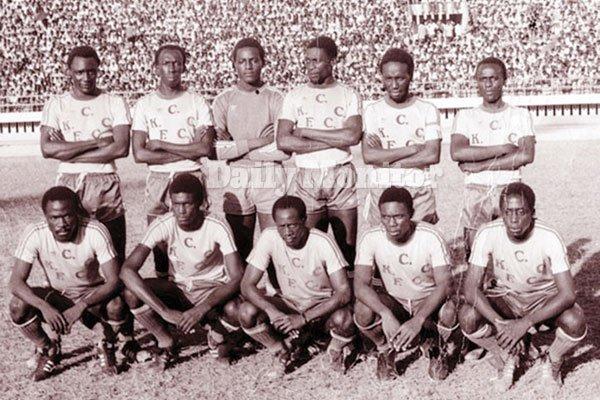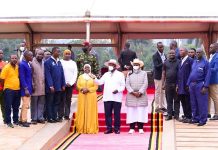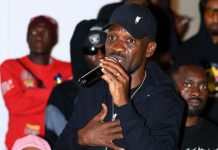Africa-Press – Uganda. Mention outstanding strikers to have graced Uganda’s soccer scene and scare goalkeepers with their bombshell strikes and be sure to include Davis Kamoga, Leo Adraa and John Ntensibe. They played for Cranes. Ntensibe, who was exceptionally gifted with both feet won the league with Express in 1974 and 1975. Kamoga was a household name at KCCA and SC Villa for unleashing powerful shots that tore nets and injured goalies while Adraa of Nsambya FC was nicknamed ‘Black Bomber’ for his scorching shots.
Davis Kamoga
His shots were deadly and at times used to burst goal nets, one reason he was nicknamed ‘The Bomber’. Fellow KCCA FC players on the other hand referred to Kamoga as ‘Kojja’ (uncle) for the respectable way he used to conduct himself.
In 1982 during a Uganda Cup semi-final tie between KCCA and Express the match was 3-3 when a late penalty was awarded to KCCA.
When Kamoga stepped out to take it, Express goalie Steve Ssegujja feared for his life and ran away from the goal rather than facing the wrath of the ‘Bomber’.
At the same time the ball mysteriously disappeared forcing Fufa to order a rematch which KCCA later won thanks to Fred Musisi Kiyingi’s solitary effort that helped them storm the final against Nile. The same year Kamoga went with the KCCA team to Khartoum for a Caf Champions League match against Al Hilal. He played a great match scoring KCCA’s two goals from fierce shots.
Al-Hilal defenders later appeared so scared that whenever Kamoga touched the ball and aimed to shoot they would just clear the way anticipating danger.
The Al-Hilal goalkeeper and captain Mustapha Nagdi refused to travel to Kampala for the return leg for fear of once again facing the bomber. Earlier on during the 1981 Cecafa Senior Challenge Cup in Mwanza, Kamoga demonstrated what a tough striker he was when he tore a goal net during an opening Group B match between Uganda and Sudan. Uganda was trailing 1-2 when the Cranes earned a free-kick outside the box.
“As I prepared to take it coach Peter Okee whispered to me to directly shoot it to the Sudanese goal. It was so powerful that it entered the goal bursting the net for an equalizer. Referring to Kamoga, one Sudanese broadcaster was widely quoted saying, “These Ugandans have sent us a giant to destroy our boys.” Uganda went on to beat Zambia 3-1 in the second group match with Kamoga doing it again. He scored another long ranger that entered the Zambian goal so fast before bouncing back for the goalie to hold it firmly unaware that it was coming from inside the net. Uganda topped the group only to lose 1-3 to Kenya in the semifinals. And who will ever forget Kamoga’s equaliser against Kenya in the 1982 Cecafa final at Nakivubo? Kamoga scored the goal shortly after being brought to the pitch.
The goal confused the Kenyans players so much saying the ball had not crossed the line. They at first decided to abandon the match until cowboy-hat-wearing Kenyan minister Paul Ngei stormed the pitch from Pavillion and urged them to continue playing. Uganda lost in the penalty shoot-out.
In the Ugandan league, many goalkeepers complained about Kamoga’s powerful shots saying he was deliberately trying to kill them. Then one day when the KCCA team was training at Lugogo, Kamoga executed a freekick that went cruising in the air, making a w sound.
At the time Jimmy Kirunda was trying his luck in goal but when heard the ball making such a sound he became so scared and ran away from the goal wondering whether it was a ball or bomb coming his way. Such was Kamoga’s artistry.
Born on October 18, 1954 at Najja in Buikwe District to Christopher Kamoga Muyomba and Nalongo Nankya, Kamoga attended Najja Primary school and later Malwonge SSS before relocating to Nyenga SSS and Uganda Martyrs Namugongo. He ended up at Kyambogo NTC graduating as a teacher and specialising in Mathematics. According to him, during his first footballing career years, he featured as a goalkeeper until one day when he felt bored with no balls coming his side.
This was at Kyambogo when he tried upfront and scored two goals. From that day Kamoga never returned to goal. “In 1971 at the age of 17, I briefly played for Busoga Stars before moving to UTC FC. Around 1977, KCCA FC tried to sign me but I declined as I was scared of the stiff competition at Lugogo and playing with very experienced and famous players,” he reveals.
He finally joined the club in 1978 around the time Uganda Cranes players had just come from Afcon in Ghana. At KCCA, he emerged a league top scorer twice in 1979 with 18 goals and 1980 after netting 21. Apart from football, from 1977 to 2003 Kamoga taught mathematics at Kibuli Secondary School where he also used to coach the school team. He was assisted by Abdallah Mubiru.
His teaching career was at times challenged especially during the time he would be away featuring for KCCA and the Cranes.
“At one time the headteacher Abbas Kawaase felt concerned with Senior Four candidate students missing mathematics lessons whenever I was away. He once suggested that I switch to teaching Senior One students but the S.4 students protested, saying it’s me they preferred and understood.
“It was later decided that I teach them at night to compensate for the days I spent away playing football,” he recalls.
Kamoga won the 1981 league at KCCA and three Uganda Cups (1979, 1980 and 1982) before moving to SC Villa winning the 1983 Uganda Cup and 1984 national league.
In 1985, Kamoga moved to home team, Buikwe Red Stars helping them win promotion to the Uganda Super League in 1986 with him being the top scorer in the Promotional Mini League.
Kamoga fact-file (Achievements)
John Ntensibe
John Baptist Ntensibe’s footballing career began at the time when the transfer of players in Uganda was conducted more or less in a mafia-style. He tells a funny story of how he emerged on the Ugandan soccer scene after graduating from Busuubizi TTC in Mityana.
Nimble-Footed. Ntensibe as he was pint-sized but a very dangerous utility player. He boasted of deadly powerful shots with both feet. PHOTO/ COURTESY.
Ntesibe was posted to teach at Kajuna primary school in Masaka from where he would spare time to play football for neighbouring clubs. During the early seventies, he featured for the Masaka Union team that played Prisons FC that came from Kampala for a build-up tour. Despite boasting of several Ugandan Cranes players, Prisons FC went down 0-2 to Masaka Union with Ntensibe scoring both goals and exhibiting a great game.
A week later two Uganda prisons land-lovers from Kampala stormed Kajuni primary school compound. Armed prison warders started shooting in the air forcing students to flee in different directions. It was later learnt that they were looking for “master Ntensibe” who had recently scored the two goals they conceded against Masaka Union.
At the staff room the prison officers arrested and handcuffed Ntensibe. Students and their teachers were ordered to the assembly with everyone wondering what sort of crime the teacher had committed. At the assembly, one senior officer broke the news by announcing that with immediate effect master Ntensibe had ceased teaching at the school and that they were taking him to Kampala to start a new life as a Prison FC player.
Ntensibe was led all the way to his residence from where his few belongings were packed and carried to one of the waiting prison vehicles and off they drove to Kampala with him. In Kampala he started his new life with a bang, scoring a hat trick in a league match against Express FC.
After the match Express FC officials that included Jolly Joe Kiwanuka and Kezekia Musisi Sseggwanga were heard questioning where Prisons FC had acquired such a gifted striker and plotted to steal him. They used their influence to get him summoned to the national youth team that was preparing to travel to Nairobi for a regional tournament. After the tournament, the Express FC officials met Ntesibe at the airport and drove him to a house they had acquired for him at Najjanankumbi outskirts of Kampala.
They hid him there for several weeks until the storm cooled down and he started playing for them. Ntensibe’s most powerful weapon during his football career appeared to be his ability to use both feet.
“One day it came to my mind that a two-footed player can easily fit in any team and quickly be summoned to the national team. Improving my ability to use both legs was the secret behind my success at both Express and in the Cranes since I could play in several positions especially at both wings,” he disclosed.
At club level, Ntensibe was part of the mighty Express FC team that won two consecutive league titles in 1974 and 1975. In 1976 when KCCA pipped them to the league title by just a point he was the club’s consolation after finishing as league top scorer with 22 goals.
In 1977 when Express was banned by league disciplinary officer and Central Province governor Maj. Abdallah Nasur, John Ntensibe and Mike Kiganda were thrown in jail at Makindye barracks where they languished for several weeks.
On coming out of the prison he joined UCB FC. Ntensibe also played for Nsambya, Nakivubo Boys and Coffee. He was part of the Nsambya team that won the 1978 Uganda Cup featuring in the 1979 African Cup winners Cup where they were eliminated by Gor Mahia of Kenya which boasted of his former teammate at Express FC, late Timothy Ayiekoh. in 1978 Ntensibe missed being included in the 1978 Cranes AFCON squad with his place going to Fred Isabirye of Simba.
The Cranes technical team thought that Isabirye had a good combination with Polly Ouma and Godfrey Kisitu at club level (Simba FC) something they would extend to the Cranes team destined for the Ghana AFCON.
John Ntensibe Fact file(Achievements)
Leo Ardra
One of the very few players that decided to ditch the national team the Cranes on their own rather than being dropped.
Adraa would have been part of the 1978 Africa Cup of Nations (Afcon) squad but abandoned the team earlier in the year in protest after Cranes officials failed to fully pay players’ allowances.
Earlier, he had been part of the team that participated in the Afcon of 1976 in Ethiopia and had been summoned to the national team as early as 1974 when playing for Nsambya FC in the lower division.
The Soccer Priest That Never Was: Adraa was prolific and equally temperamental either as a player or as a coach. A tale is told of when he absconded from the Cranes camp in 1978 after the team went without pay for some months.PHOTO/ EDDIE CHICCO.
During his entire football career, Adraa played for only one club – Nsambya FC. There is no reward for guessing how he came to join the club that was founded by Catholic missionaries.
Adraa attended catholic seminaries like Pokea, Katigondo Major Seminary in Masaka and went all the way to Ggaba National Major Seminary. He missed becoming a priest by whisker after he failed to get ordained. “This was when I discovered that I had no vocation and was in the wrong place,” Adraa told Sunday Monitor.
“So I had to pack my bags and leave to work at the East African Examination Council.”
Then it was a custorm for gifted priests like late Fr. Charles Bwenvu and major seminarians to play for the religiously founded Nsambya FC. Adraa studied philosophy at Katigondo Major Seminary in Masaka and Theology at Ggaba. He revealed that at both major seminaries, he was a year ahead of the current Archbishop of Kampala Dr. Cyprian Kizito Lwanga.
“Though Archbishop Lwanga didn’t play football, he was a great cheer leader who used to support seminary teams and would travel with us wherever we went to compete and offer his support.” Adraa remembers joining Nsambya FC around 1972 and playing alongside the likes of Former Fufa president John Baptist Ssemanobe, Raphael Bwire, and Barnabas Mwesiga among other stars. Nsambya then was well known for applying long balls, a system that often disorganised some giant teams with a completely different style of playing short passes.
Adraa was nicknamed ‘Black Bomber’ not for nothing. He used to unleash powerful shots and at times would score from as far as 30 yards.
One of his most memorable matches was during the 1977 Cecafa hosted by Somalia. He was brought on to the pitch to replace Denis Obua when Uganda was trailing Kenya 1-0 and scored two long range shots to make it 2-1 with Cranes adding another to win 3-1. Adraa recalls the golden days when football matches attracted huge crowds and wonders what went wrong.
“For matches involving either KCCA, Express, Simba or Prisons fans would fill up Nakivubo as early as 10am yet when matches were to kick off at 4pm. Fans from both sides would meanwhile party and sing in praise of their teams with everything looking so attractive.”
He was part of the Cranes team that won two consecutive Cecafa titles in 1976 and 1977. In 2000 long after retiring, Adraa went to Germany for a coaching course and later handled almost all levels of the national youth teams, the Cranes, South Sudan and clubs like Nsambya, Arua Young, Express, Scoul, Kinyala, Boroboro, Onduparaka and Fire Masters among others.
He was appointed Express coach twice between 2002-2003 and 2004-2005. Apart from once managing the Cranes team, in 2012 Fufa appointed him as Cranes psychologist replacing deceased David Otti.
According to the man himself, one of his best coaching moments came in 1999 when he was at the helm as the Uganda Kobs reached the semifinals of the All African Games in South Africa, a team with very gifted boys that were later to feed the senior Cranes team for years.
“Those boys put up an outstanding performance down there. I will never forget the moment Ibrahim Ssekagya charged at Andrew ‘Fimbo’ Mukasa blaming him for having deliberately refused to score a goal in one match. Fimbo hit back reminding Ssekagya it was his goals that had pushed the team all that far,” Adraa recalls the rather cheeky moment.
Leo Adraa Fact file (Achievements)






